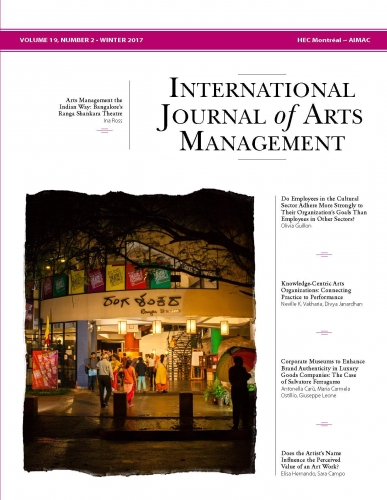Arts Management the Indian Way: Bangalore’s Ranga Shankara Theatre
Produit: Article
21,00 $ CA
Ina Ross
Ina Ross has served as Executive Director of the Bauhaus foundation in Dessau and as an associate professor of Arts Management at the Academy of Performing Arts Ernst Busch in Berlin. She now teaches Arts Management at the National School of Drama in New Delhi. She is the author of Wie überlebe ich als Künstler? [How to Survive as an Artist] (Transcript Verlag, 2013), which discusses creativity as a marketing strategy.
ABSTRACT
In cinema-crazy India there are few spaces dedicated exclusively to live theatre. Theatre in the Western sense, with a permanent stage and regular performances based on literary texts, is seen as a leftover from the colonial period, an imported institution, whereas the original Indian performing arts tradition is closely linked to folk and religious events and festivals. The Ranga Shankara theatre in Bangalore has been remarkably successful in this difficult cultural and market environment. The author discusses Ranga Shankara’s management and marketing strategies. The experiences of multinational corporations in the Indian market and their reflection in the business literature provide a conceptual and comparative framework for understanding how a “foreign” cultural institution such as theatre can find an Indian audience.
KEYWORDS
Indian theatre, non-Western branding, audience development, postcolonial institution, non-Western marketing, emerging markets
RÉSUMÉ
Il existe peu d’endroits en Inde, où le cinéma est maître, qui sont dédiés exclusivement au théâtre. Le théâtre tel que pratiqué en Occident, avec une scène permanente et des représentations basées sur des œuvres littéraires, est perçu comme un vestige de la période coloniale, une institution importée. Or, il existe une tradition des arts de la scène d’origine indienne qui est étroitement liée aux événements et festivals religieux et folkloriques. Le théâtre Ranga Shankara situé à Bangalore connait un succès remarquable dans cet environnement et ce marché difficile. L’auteur présente les stratégies de management et de marketing utilisées par Ranga Shankara. Les expériences de sociétés multinationales opérant dans le marché indien et les études qui y ont été consacrées dans les publications d’affaires fournissent un cadre de référence conceptuel et comparatif qui permet de comprendre comment une institution culturelle « étrangère », comme un théâtre, peut attirer un public indien.
MOTS CLÉS
Théâtre indien, positionnement de marque non occidental, développement des publics, institution postcoloniale, marketing non occidental, marchés émergents
RESUMEN
En una India loca de cine hay pocos espacios dedicados exclusivamente al teatro en vivo. El teatro en su sentido occidental, con una escena permanente y representaciones regulares basadas en textos literarios, se consideran reliquias del período colonial, una institución importada, mientras que la tradición original de las artes escénicas indias está estrechamente relacionada a los eventos y festivales folklóricos y religiosos. El teatro Ranga Shankara en Bangalore ha tenido un éxito notable en este entorno cultural y de mercado difícil. La autora expone las estrategias de gestión y mercadeo de Ranga Shankara. Las experiencias de las empresas internacionales en el mercado indio y su reflejo en la literatura empresarial constituyen un marco conceptual y comparativo para comprender cómo una institución cultural “extranjera” como el teatro logra gozar de un público en India.
PALABRAS CLAVE
Teatro indio, marca no occidental, desarrollo de público, institución poscolonial, mercadeo no occidental, mercados emergentes

